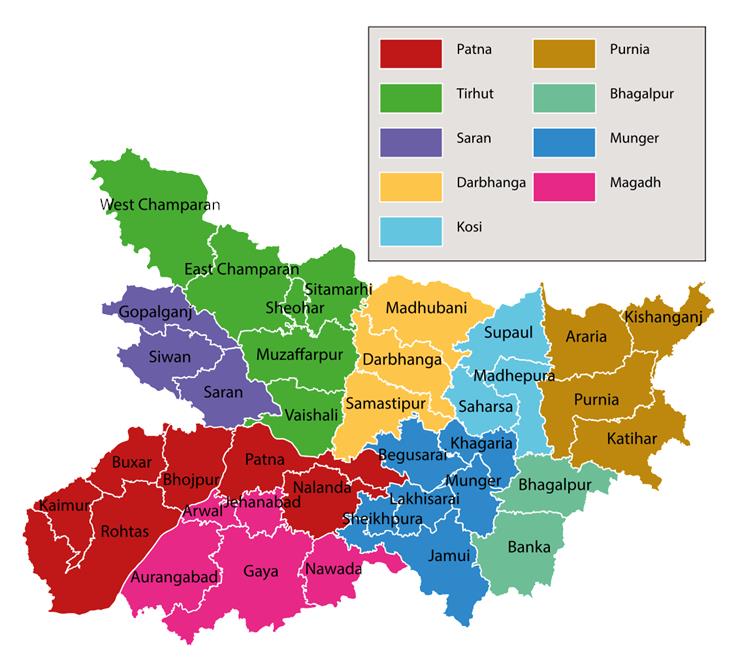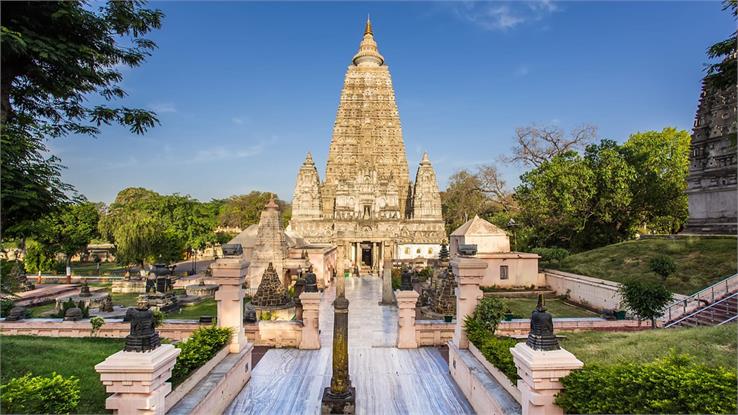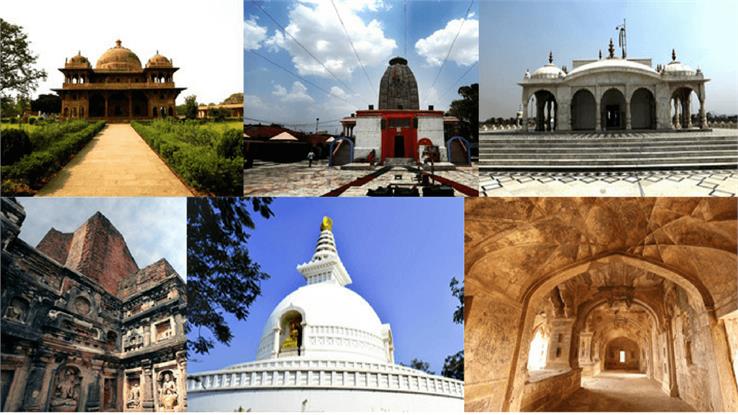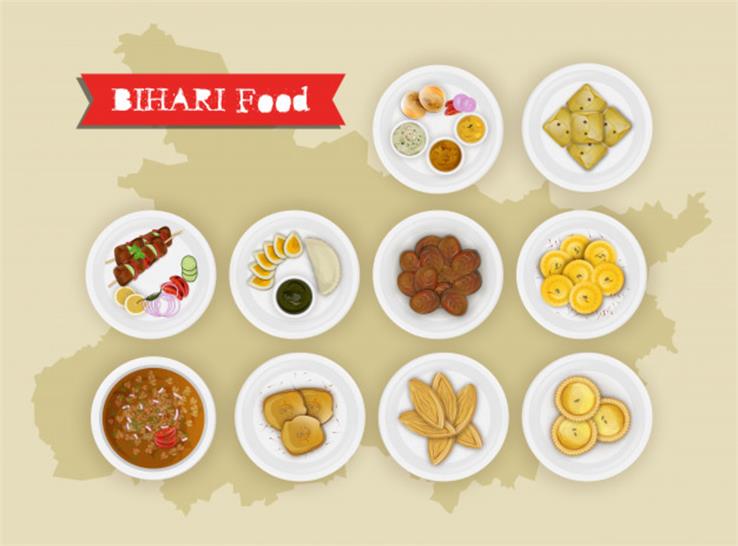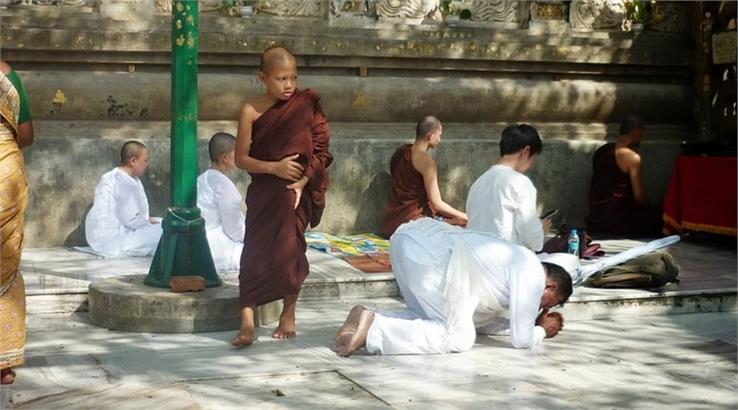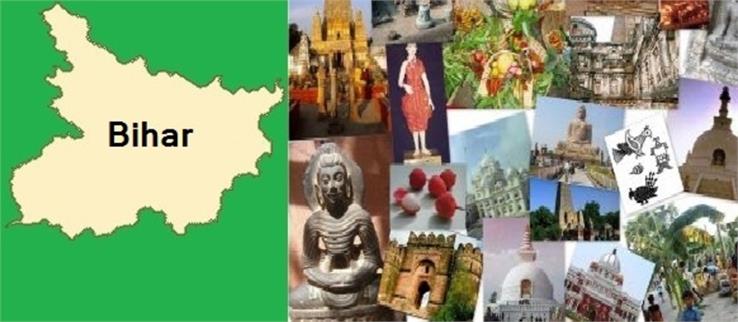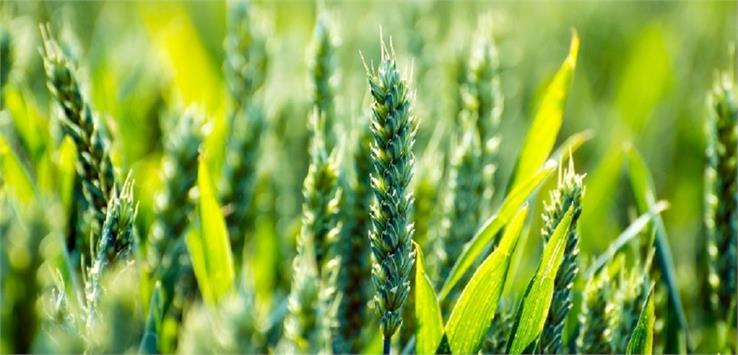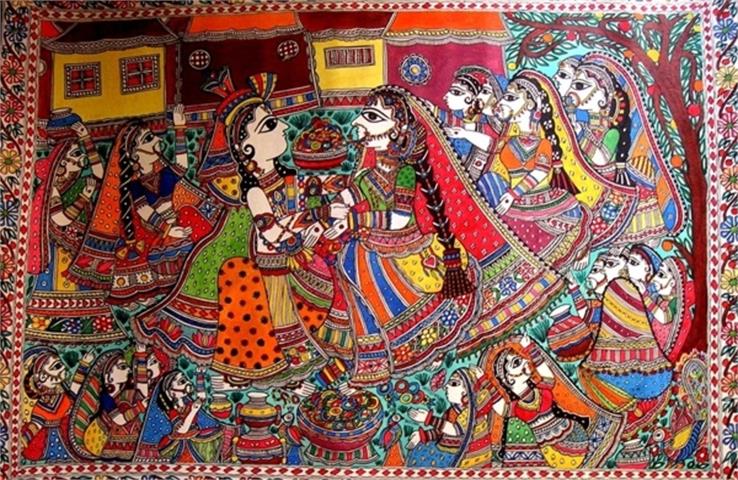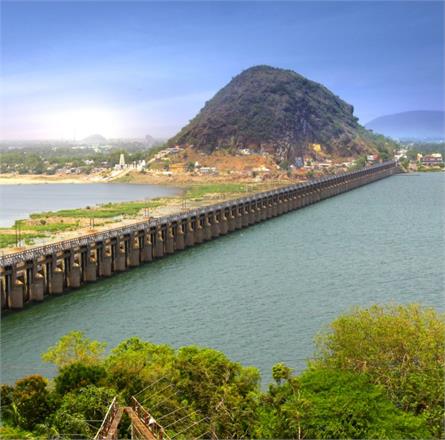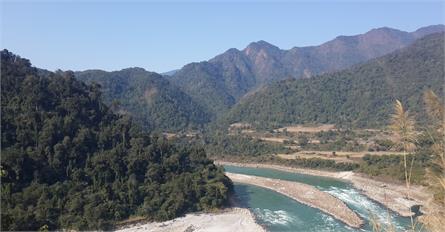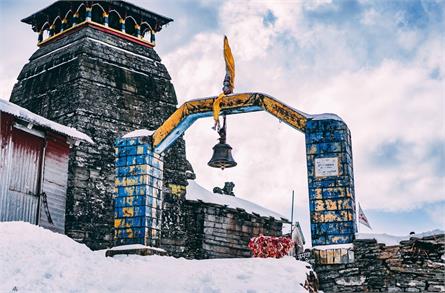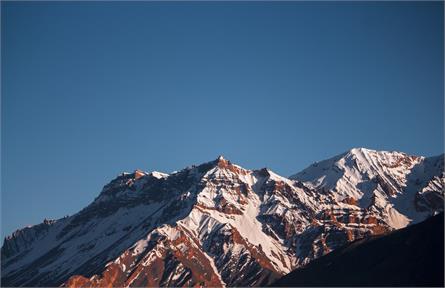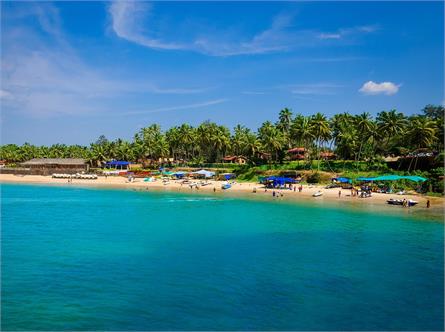Bihar - State beyond Litti Chokha
Bihar is a beautiful state of India which shares its boundaries with West Bengal, Uttar Pradesh, Nepal, and Jharkhand. The capital city of Bihar is Patna (earlier named Pataliputra), an excellent destination for tourism.
Bihar has been a center of tourist places, historical heritage, religion, spirituality, and culture. It is a state that gave two religions to the world - Buddhism and Jainism.

Eastern state of India and divided by the river Ganges, the ancient name of Bihar was 'Vihara,' which means Math. Bihar is the third most populated and twelfth largest state by area. The Ganges River flows through this state before reaching the Trikona region of Bengal, due to which the state is rich in flora and fauna. The forest area of Bihar is also huge, which is 6,764 sq. km. Follow the command of some most glorious Kings of India, Bihar became the hub of leadership, culture, and education, knowledge, and wisdom. Some of them are Samudragupta, Chandragupta Maurya, and Ashoka. There were also two great education centers at that time, Vikramashila and Nalanda University. It also embraces the Mahabodhi Temple, which has been declared a heritage site by UNESCO.
History
Ancient Bihar, i.e., Magadha, worked amazingly in the field of vigor, strength, tradition, education, intelligence from thousands of years. The first Indian empire named Maurya was started in Magadha in 352 AD, and its capital was Pataliputra (Patna). The Gupta Empire came to Magadha in 240 AD. India ruled the world's economy in the guidance and leadership of Gupta. The great Pashtun ruler of Sasaram in Bihar, Sher Shah Suri, led the command of North India in 1540. He was one of the most progressive rulers during the Mughal period, and Bihar flourished under his rule. The Nawabs of Bengal rule over Bihar after the downfall of the Mughals.
Bihar is mentioned in the Vedas, Puranas, and ancient epics. The state has been the workplace of Mahatma Buddha and 24 Jain Tirthankaras. In BCE, the rulers of Maurya, Sunga, and Kanva dynasties including Bimbisara, Udayan, Chandragupta Maurya, and Emperor Ashoka, who established the region were ruled by the Kushan rulers. Later Chandragupta Vikramaditya of the Guptas dynasty ruled Bihar. Moreover, Muslim rulers had presided over the region in the medieval period. The first Muslim ruler to conquer Bihar was 'Mohammad bin Bakhtiar Khilji.' The Khilji dynasty was followed by the Tughlaq dynasty and the Mughal dynasty. Dr. Ansari (1880–1936 AD) was a prominent Muslim nationalist leader who was born in Bihar.
Geography
The state is naturally divided into two parts by the Ganges River, the North Bihar Plain, and the South Bihar Plain. Except for Himalayan foothills in the far northwest, the northern plain of the Ganges forms the alluvial equine area at an altitude of less than 75 meters above sea level. There is always a possibility of a flood in this region. The Ghaghara, Gandak, Bagmati, Kosi, Mahananda, and other rivers descend from the Himalayas in Nepal and join the Ganges river through different waterways.
Lakes and troughs are evidence of these lost streams. The Kosi river is known as the 'Sorrow of Bihar' as it brings devastating floods, which is now limited to artificial embarkations. The soil of the northern plain is mostly new alluvial soil, with molasses and light-mossy to the west of the old Gandak River, whereas albumen-free and heavy-mossy (loam) to the east. Being located in the seismic zone of the Himalayas, this region is affected by another natural disaster (seismic activities). The horrific earthquakes of 1934 and 1988 caused massive destruction and damage to life and property.
The Kaimur plateau, located across the Son valley in the south-west, is covered with a layer of horizontal sandstone. The South Gangetic Plain is more diverse than the North, and many hills rise from the alluvial surface. All the rivers are small except the Sone river, whose water is diverted to irrigation canals. The soil here is relatively old alluvial, composed of black smooth or yellow loam soil.
Major Cities of Bihar

- Arrah/Ara
- Aurangabad
- Bagaha
- Begusarai
- Bettiah
- Bhagalpur
- Bihar Sharif
- Buxar
- Chhapra
- Danapur
- Darbhanga
- Dehri
- Gaya
- Hajipur
- Jamalpur
- Jehanabad
- Katihar
- Khagaria
- Kishanganj
- Madhubani
- Maner
- Motihari
- Muzaffarpur
- Munger
- Nalanda
- Nawada
- Patna
- Purnia
- Saharsa
- Samastipur
- Sasaram
- Sitamarhi
- Siwan
Climate
There are mainly three seasons in Bihar. Summer from March to Main June, Southwest monsoon rainy season from mid-June to October, and winter from November to February.
May is the hottest month in the state except far north, in which the temperature also crosses 32°C. The average annual rainfall in the state ranges between 1,016 mm in the west-central and 1,524 mm in the faraway north. Almost the entire rainfall (85-90 percent) occurs between June and October, and about 50 percent of the annual rainfall is in the months of July and August. Winter is the most pleasant season of rain in Bihar.
Economy
About 75 percent of the population of Bihar is engaged in agricultural work. Despite a remarkable achievement in mining and manufacturing in the second half of the 20th century, Bihar is the last in the country in terms of per capita income, and nearly half of the state's population is administratively below the poverty line. With the formation of Jharkhand, its problems have increased, and Bihar has been deprived of huge reserves of mineral wealth. The economy of Bihar is lagging due to the lowest per capita income and extremely dense population.
Agriculture

The economy of Bihar is based on agriculture. The total area of Bihar is approximately 93.60 lakh hectare, from which the cultivated area is about 56.03 lakh hectare. The state has about 79.46 lakh hectares of cultivable land in its arena. Irrigation facilities are available on a total land of 43.86 lakh hectares by various means, whereas about 33.51 lakh hectares of land is irrigated. Bihar's major food crops are paddy, pulses, and maize. On the other hand, potato, sugarcane, oilseeds, chili, tobacco, and jute are cash crops of Bihar. Forests are spread over an area of about 6,764.14 sq km, which is about 7.1 percent of the total geographical area of the state.
Industry
The main industries of the state are -
- 'Bharat Wagon Limited' has railway wagon plants at Muzaffarpur and Mokama.
- Indian Oil Corporation has an oil refinery at Barauni.
- HPCL of Barauni and Amjhor's Pyrites Phosphate and Chemicals Ltd. (PPCL) are fertilizer plants of the state.
- There are five large yarn spinning mills at Siwan, Bhagalpur, Pandoul, Mokama, and Gaya.
- There are 13 sugar mills in North and South Bihar in the private sector, and 15 sugar mills are in the public sector, whose total crushing capacity is 45,00 TPD.
- Apart from this, there are wine factories in Gopalganj, West Champaran, Bhagalpur, and Riga (Sitamarhi district).
- There are leather processing industries in West Champaran, Muzaffarpur, and Barauni and three big jute factories in Katihar and Samastipur.
- There are medicine factories in Hajipur, food processing, and vegetable making factories in Aurangabad and Patna.
- A cement factory named Kalyanpur Cement Limited in Banjari has an important place in the industrial map of Bihar.
Irrigation
The total irrigation potential in Bihar is 28.63 lakh hectares. This capacity is mobilized from large and medium irrigation projects. Large and medium irrigation projects have been created here, and 48.97 lakh hectare area is irrigated through major irrigation schemes.
Transportation
Bihar's transport system has been affected by rivers since the beginning. The state's transport system is mainly dependent on the Ganges River, where transport is provided by ferry to the banks of rivers. Bihar is connected to several states of North India by road. Chandragupta Maurya built the highway that runs from Chittagong, Bangladesh to Kabul, Afghanistan in 1542 AD. This road was then called ‘Uttarapatha’ and was rebuilt by Sher Shah who named it as 'Sadak-e-Azam'; nowadays, it is known as ‘The Grand Trunk Road/G.T. Road.’ This road passes through the state of Bihar. Roadways and railways play a vital role in Bihar's transport system, but the development of water transport has been limited. There are mainly four modes of transportation in Bihar.
Roadways
Since ancient times, Bihar has been connected to other parts of North India by road. The administrative and economic system of the ancient rulers was based on on-site routes. Emperor Ashoka made magnificent Magadha the capital of Bihar and built the state road between Rajagaur and Pataliputra. The road was constructed by the Mughal rulers and Sher Shah Suri in the medieval period. The total length of roads in Bihar in 1947 AD was 1315 km. Presently, the length of the roads is 67116 km. National road is the primary road system of the state of Bihar. National road is the primary road system of the state, which is maintained by the central government. 4717 km long roadway has been constructed in the state. Apart from this, 26092 km Long roads are being made of two lanes.
Provincial highways are those which connect the district headquarters and the state capital. Roads in the plains of Bihar are submerged in rainwater.
Local roads are connecting the district headquarters to the towns and villages. It is made of bricks and breaks down due to rain.
As of March 2008, Bihar had 45,721.059 km of paved roads. These include 3,734.38 km of national highways, 3,766.029 km of provincial highways, 7,992.65 major district roads, 2,828 km of other district roads, and 27,400 km of rural roads.
Railways
There is a good network of railway lines in Bihar, but the transport system in North Bihar is a bit difficult due to the only railway bridge in Mokama. Railroads connecting some essential places, such as Muzaffarpur-Samastipur-Barauni-Katihar and Samastipur are the main railway junctions of the state.
Aviation
Bihar has a restricted international airport, Jay Prakash Narayan International Airport in Patna besides airstrips. Another one is Gaya Airport (located in Gaya) that majorly serves domestic flights, but also operates seasonal flights to international destinations.
Waterways
As discussed, The state of Bihar is blessed with a bounty of rivers and tributaries that flow through the state. Due to which Bihar is well connected with National Waterways No. 1, established in October 1986. Haldia, BISN (Kolkata), Pakur, Farrakka, and Patna are the fixed terminals of National Waterways No. 1.
Education
Everybody knows that development and progress demand for the educated mind; hence, education and knowledge reveal the usual status of the state or nation. Bihar is moving ahead in this area, but it is still nothing more than a beginning. There is a considerable gap in demand and supply because of a scarcity of education infrastructure in modern Bihar. Bihar has the highest teacher-student ratio, and student-class ratio and even the teacher's absence rate is 37.8, which creates a dilemma for the growth and development of the state.
Although Bihar's education rate nearly tripled to about 48 percent of the state's population in the second half of the 20th century, it is still significantly lower than the education rate of other states. The male literacy rate (60.32 percent) is almost double as compared to the female literacy rate (33.57 percent). The prime goal of the state is to educate all children up to the age of 14 years. About 90 percent of these children are eligible to enroll in primary schools, but very few of them reach the secondary level because their financial requirements compel them to work. Government departments aid vocational and technical educational institutions. Among the higher educational institutions of Bihar, the ancient and important Patna University in Patna; Babasaheb Bhimrao Ambedkar Bihar University in Muzaffarpur, and 'Tilka Manjhi Bhagalpur University' located in Bhagalpur. Both the latter educational institutions offer graduate-level courses in various disciplines, and many colleges are affiliated to them. Specialized subjects are educated at The Patna School of Arts and Crafts.
Top universities of Bihar
According to 2019 Bihar University Ranking, the top universities of Bihar are:
- Lalit Narayan Mithila University, Darbhanga
- Magadh University, Bodh Gaya
- Indian Institute of Technology Patna
- National Institute of Technology, Patna
- All India Institute of Medical Sciences Patna, Patna
- Babasaheb Bhimrao Ambedkar Bihar University, Muzaffarpur
- Patna University, Patna
- Tilka Manjhi Bhagalpur University, Bhagalpur
- Dr. Rajendra Prasad Central Agricultural University
- Central University of South Bihar, Patna
- Bhupendra Narayan Mandal University, Madhepura
- Veer Kunwar Singh University, Arrah
- Mahatma Gandhi Central University, Motihari
- Nalanda University, Rajgir
- Aryabhatta Knowledge University, Patna
- Chanakya National Law University, Patna
- Indira Gandhi Institute of Medical Sciences, Sheikhpura
- Jai Prakash Vishwavidyalaya, Chhapra
- Bihar Agricultural University, Bhagalpur
- Nava Nalanda Mahavihara, Bargaon
Languages of Bihar
The name Bihari is synonymous with various languages spoken in Bihar and its neighboring states. Maithili, Magahi, Bajjika, Bhojpuri, and Angika are the popular languages of Bihar. Despite the fact that all these languages are widely spoken in Bihar, no other language except Maithili got constitutional recognition. Hindi is the primary language of Bihar, Hindi and Urdu are used in education and government affairs. The Magahi language derives its name from Magadhi Prakrit, which was the official language of the Maurya Empire and was also spoken by Lord Buddha. Magahi is written in the Devanagari script. It is spoken in eight districts of Bihar and three districts of Jharkhand. Bhojpuri is also a very popular language of Bihar, and it is the third most spoken language in India.
Cultural Life
The cultural region of Bihar indicates a close relationship with the linguistic area. Maithili is the language of ancient Mithila (Videha, present-day Tirhut), in which the Brahminical system of life predominates. Maithili is the only dialect of Bihar, which has its own script (Tirhuta) and rich literary history. Vidyapati, a famous Maithili and Sanskrit poet, is famous for his adornments and devotional songs among the oldest and most famous creators of Maithili.
Literature
There is hardly any written literature in the Bhojpuri dialect, but its oral folk literature is abundant. Magahi's folk literature is also vibrant. The creators of the plains of Bihar have contributed significantly to modern Hindi and Urdu literature.
Fairs and Festivals
Bihar is the birthplace of Gautama Buddha and Lord Mahavira. Therefore, the culture of Bihar is a legacy of a great historical past. Moreover, the state has many folk songs and dances which are performed on special occasions. 'Sohar' is sung at the time of childbirth, 'Sumangali' is sung at the wedding, 'Katnigit' while sowing the first paddy and 'Ropani geet' is during harvest. Some of the popular folk dance styles of Bihar are Gond Nach, Dhobi Nach, Jhumar Nach, Jitiya Nach.
The major fairs and festivals in the state are:
Apart from Diwali, some festivals are celebrated solely in Bihar. One such festival is Chhath Puja. The Sun God is worshipped here with great reverence.
- Sama Chakeva
Sama Chakeva is celebrated with enthusiasm in Mithila during the winter months when migratory birds from the Himalayan Mountains visit the region.
Makar Sakranti is another famous festival of Bihar.
- Shravani fair
Shravani fair is organized in a 105 km long area from Sultanganj to Devghar in Bhagalpur district of Bihar. This fair is held every year in the Hindu month of Shravan, i.e., the lunar month of July-August. The believers visit Baba Baidyanath Temple to pray from different states of India. The temple, also known as Baidyanath Dham, is one of the 12 Jyotirlingas and the most sacred abodes of Shiva.
- Sonepur Cattle Fair
Sonepur Mela is held every year on the Kartik Purnima (November-December) since 1850 in Sonepur, Bihar. It is the largest cattle fair in Asia. The fair is also known as 'Harihar Kshetra Mela.' The fair is held on the banks of Gandak in Sonepur, about 25 km from Patna, and 3 km from Hajipur, the headquarters of the Vaishali district.
Pitrapaksha Mela, Rajgir Mahotsav, Bihula, and, Buddha Jayanti are some more special occasions to witness different colors of Bihar.
Government and Politics of Bihar
Since independence, the socio-economic condition of Bihar has been declining due to which it has been counted among backward states of India. Bihar has four major political parties including BJP, Janata Dal, Lok Janshakti Party, and Rashtriya Janata Dal. Bihar has been divided into nine divisions and 38 districts for better administration. During the post-independence Emergency, Bihar held elections under the leadership of Jayaprakash Narayan and told the country that he believed in choosing democracy over dictatorship. Janata Dal came to power in Bihar during 1990, and Lalu Prasad Yadav became the Chief Minister. However, he also failed to develop Bihar and resigned from the post of Chief Minister due to the rise in corruption and made his wife, the Chief Minister. It was the time when Bihar saw a decline in all social aspects.
Currently, Nitish Kumar is the present chief minister of Bihar since 2017.
Places to Visit
There are many scenic, historical, and pilgrimage sites in the state of Bihar, which makes it worth visiting. Some of them are:

- Mahabodhi Temple
- Golghar
- Barabar Caves
- Patna Museum
- Giant Buddha
- Sanjay Gandhi Jaivik Udyan
- Dungeshwari
- Takhat Shri Harimandir Ji Patna Sahib
- Mahatma Gandhi Setu
- Buddha Smriti Park
- Tomb of Sher Shah Suri
- Bihar Museum
- Kakolat Falls
- Patna Planetarium
- Mundeshwari Temple
- Royal Bhutan Monastery
- Rohtasgarh Fort
- Nalanda Archaeological Museum
- Navlakha Palace
- Saptaparni Cave
Best time to Visit
The best time to visit the state Bihar of India is considered to be between October to March. It is because, during this time, visitors can visit various tourist destinations of Bihar state without any hassle.
Food - What to Eat?
Bihar is not only known for its tourism but also famous for its delightful and delicious food items. Tourists will find both vegetarian and non-vegetarian food in the local cuisine of Bihar.
Vegetarian is preferred mostly, but meat is also acceptable. Pulses, rice, bread, vegetables, pickles, papad, sattu are preferred in the regular meal. Litti-chokha has gained global recognition as Bihari food. The sweets of Bihar are mostly dry, some of them are Lakto, Khurma, Balushahi, Anarsa, Khaja, Motichur laddu, Kala Jamun, Kesariya Pada, Parwal ki Mithai, Khubi ka Lai, Belgrami, Tilkut, Thuka, and Chena Murki.
Some of the main dishes of Bihar are mentioned below:

- Litti Chokha
- Malpua
- Dal puri
- Makhana Kheer
- Chandrakala/ Pedakiya
- Chana Ghugni
- Khaja
- Kesar Peda
- Dal Peetha
- Thekua/Khajuria
Where to Stay?
The following are top hotels, resorts, and ashrams in various cities of the state, where one can spend quality time.
- Oaks Bodhgaya
- Hotel Patliputra Nirvana, Patna
- Patliputra Exotica, Patna
- Maya Heritage Hotel, Bodh Gaya, Bihar
- Hotel Vinayak International, Patna
- The Rajgir Residency Hotel, Rajgir, Bihar
- Indo Hokke Hotel, Rajgir, Bihar
Shopping
Bihar is a basket of nature, which is full of ethnic products of the state. Wood carving, woodwork items, clay pottery are famous for buying from Bihar. One can buy various things from the market of Bihar, such as:

- Famous handloom silk of Bhagalpur
- Zari embroidery and Kashida work fabric
- The lacquer work bangles
- Ethnic designed silver jewelry
- Madhubani paintings
- Traditional beadwork items
Bihar is a blessed land with multi-ethnicity and cultures. Creating its presence in eastern India, the state is known to be the most diverse state in the country. The state continues to evolve and is a true reflection of ‘India and its diversity.’


